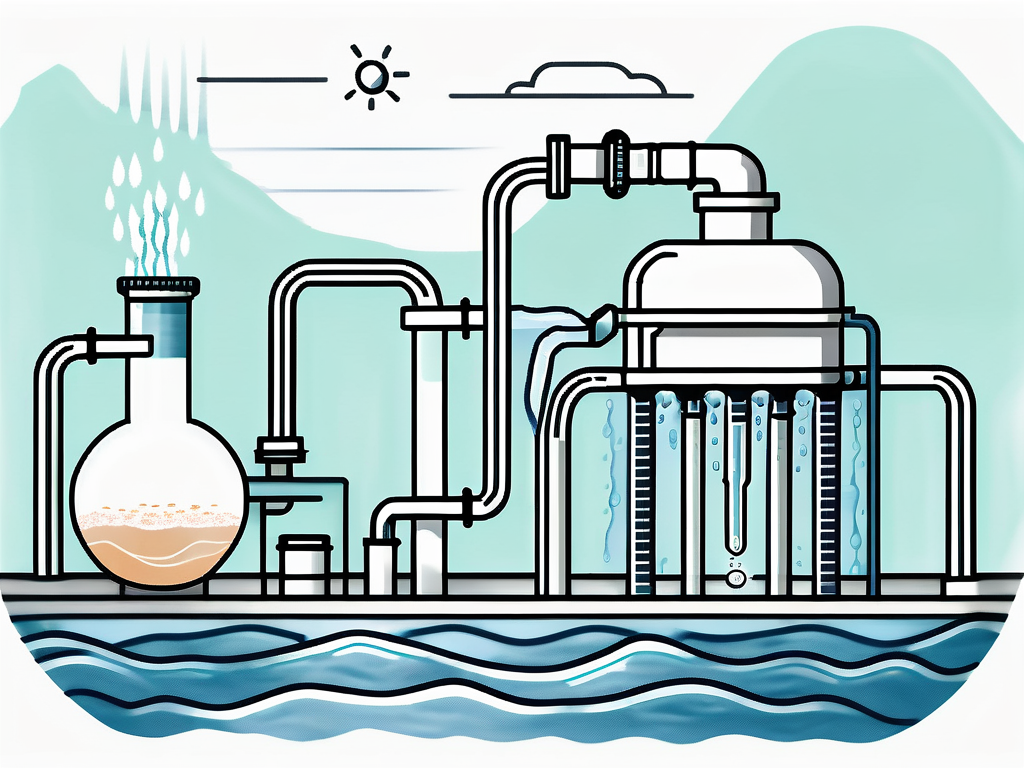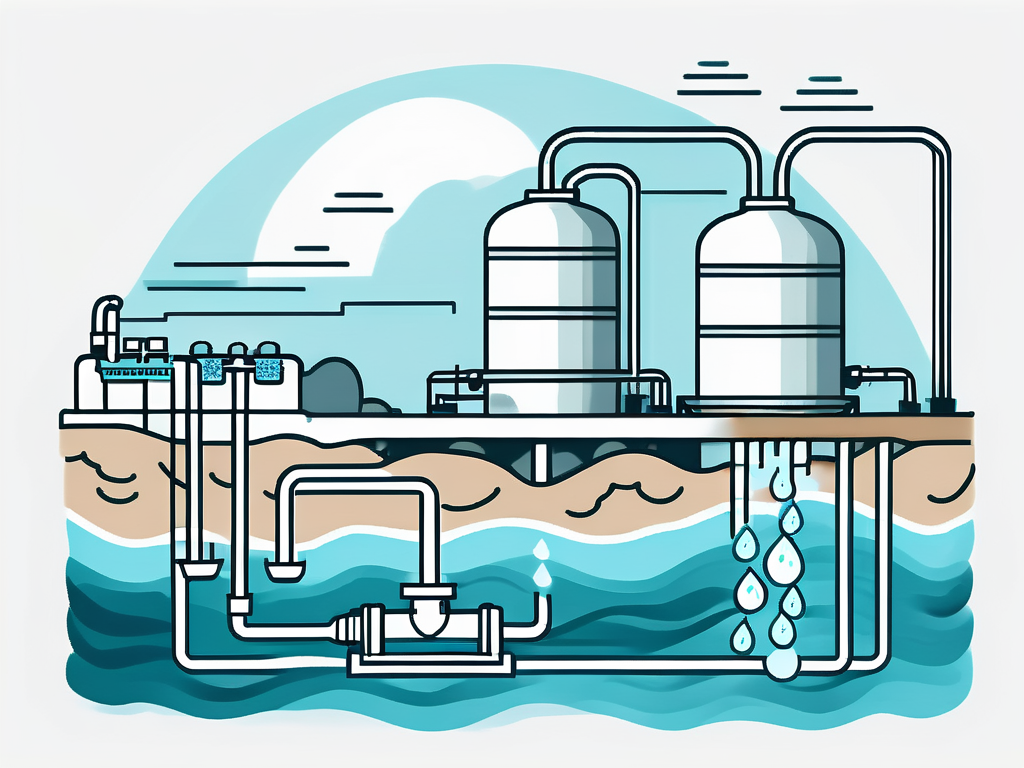
Desalination: Wastewater Treatment Explained
Desalination is a critical process in wastewater treatment, particularly in regions where fresh water is scarce. This process involves removing dissolved salts and other minerals from seawater or brackish water, making it suitable for human consumption and use in agriculture and industry. The increasing global water crisis has made desalination an essential technology for ensuring water security.
While desalination has been practiced for centuries, modern technologies have made the process more efficient and environmentally friendly. However, the process is still energy-intensive and can have significant environmental impacts. This article will delve into the intricacies of desalination as a wastewater treatment method, discussing its principles, techniques, benefits, challenges, and future prospects.
Principles of Desalination
Desalination is based on the principle of separating salts and other dissolved solids from water. This is typically achieved by either using a semi-permeable membrane that allows water molecules to pass through but blocks larger salt ions, or by distillation, where water is evaporated and then condensed, leaving behind the salts.

Regardless of the method used, the goal of desalination is to produce water that meets the quality standards for drinking water. This involves not only removing salts but also other potential contaminants such as bacteria, viruses, heavy metals, and organic compounds.
Membrane Processes
Membrane processes in desalination involve the use of a semi-permeable membrane to separate salts from water. The most common membrane processes are reverse osmosis (RO) and electrodialysis (ED). In RO, pressure is applied to the saline water to force it through the membrane, while in ED, an electric field is used to drive ions through the membrane.
Membrane processes are favored for their energy efficiency and the high quality of water they produce. However, they require regular maintenance to prevent fouling and scaling, which can reduce their performance and lifespan.
Thermal Processes
Thermal processes involve heating saline water to create steam, which is then condensed to produce fresh water. The most common thermal processes are multi-stage flash (MSF) distillation and multi-effect distillation (MED). These processes are energy-intensive but can produce very high-quality water.
Thermal processes are typically used in regions with abundant cheap energy, such as the Middle East. They are also used in conjunction with power plants, where waste heat from the power generation process is used to heat the saline water.
Techniques of Desalination
There are several techniques used in desalination, each with its own advantages and disadvantages. The choice of technique depends on various factors such as the source and quality of the feed water, the required quality of the product water, the available energy sources, and economic considerations.
The most commonly used desalination techniques are reverse osmosis, multi-stage flash distillation, and electrodialysis. Other techniques include nanofiltration, forward osmosis, and solar desalination.
Reverse Osmosis (RO)
Reverse osmosis is the most widely used desalination technique. It involves applying pressure to the saline water to force it through a semi-permeable membrane. The water molecules pass through the membrane, while the larger salt ions are retained.
RO is favored for its energy efficiency and the high quality of water it produces. However, it requires a high initial investment and regular maintenance to prevent fouling and scaling of the membrane.
Multi-Stage Flash Distillation (MSF)
Multi-stage flash distillation is a thermal desalination technique that involves heating saline water in a series of stages, each at a lower pressure than the previous one. This causes the water to flash evaporate, creating steam that is then condensed to produce fresh water.
MSF is energy-intensive but can produce very high-quality water. It is typically used in regions with abundant cheap energy or in conjunction with power plants, where waste heat from the power generation process is used to heat the saline water.
Electrodialysis (ED)
Electrodialysis is a membrane desalination technique that uses an electric field to drive ions through a membrane. The saline water is passed between pairs of positive and negative electrodes, which attract the negatively and positively charged ions, respectively.
ED is less energy-intensive than RO and MSF and can handle higher salinity levels. However, it produces lower quality water and requires regular maintenance to prevent fouling and scaling of the membrane.
Benefits of Desalination
Desalination offers several benefits, particularly in regions where fresh water is scarce. It provides a reliable and sustainable source of fresh water, independent of rainfall or surface water availability. This can be crucial in arid regions or during periods of drought.

Desalinated water is also of high quality, meeting the standards for drinking water. This makes it suitable for a wide range of uses, from domestic consumption to industrial processes and irrigation.
Water Security
Desalination provides a reliable and sustainable source of fresh water, enhancing water security. This is particularly important in arid regions and islands, where fresh water resources are limited. Desalination can also be a crucial tool in managing water scarcity during periods of drought.
By providing a source of fresh water independent of rainfall or surface water availability, desalination can help reduce dependence on imported water and improve resilience to climate change.
High-Quality Water
Desalinated water is of high quality, meeting the standards for drinking water. This makes it suitable for a wide range of uses, from domestic consumption to industrial processes and irrigation.
By removing salts and other potential contaminants, desalination can improve the taste and safety of the water. This can be particularly beneficial in regions where the natural water sources are contaminated or of poor quality.
Challenges of Desalination
Despite its benefits, desalination also poses several challenges. These include high energy consumption, environmental impacts, and high costs. Addressing these challenges is crucial for the sustainable development and adoption of desalination technologies.
Research and development efforts are ongoing to improve the efficiency and reduce the environmental impacts of desalination. These include the development of new materials and technologies, as well as the integration of renewable energy sources.
Energy Consumption
Desalination is an energy-intensive process, particularly for thermal techniques. This not only increases the cost of desalinated water but also contributes to greenhouse gas emissions.
Efforts are ongoing to reduce the energy consumption of desalination, including the development of more efficient membranes and the integration of renewable energy sources. However, these solutions are still in their early stages and require further research and development.
Environmental Impacts
Desalination can have significant environmental impacts, particularly due to the disposal of the concentrated brine byproduct. This brine is typically discharged back into the sea, where it can harm marine life due to its high salinity and the presence of chemicals used in the desalination process.
Efforts are ongoing to mitigate the environmental impacts of desalination, including the development of brine treatment technologies and the use of less harmful chemicals. However, these solutions are still in their early stages and require further research and development.
High Costs
Desalination is a costly process, requiring high initial investment and ongoing maintenance costs. This makes desalinated water more expensive than other sources of fresh water, limiting its affordability and accessibility, particularly in developing countries.
Efforts are ongoing to reduce the cost of desalination, including the development of more efficient and durable membranes, as well as the integration of renewable energy sources. However, these solutions are still in their early stages and require further research and development.
Future Prospects of Desalination
The future of desalination looks promising, with ongoing research and development efforts aimed at improving its efficiency, reducing its environmental impacts, and making it more affordable. These include the development of new materials and technologies, as well as the integration of renewable energy sources.
With the increasing global water crisis, desalination is expected to play a crucial role in ensuring water security. However, its sustainable development and adoption require addressing its challenges and balancing its benefits with its environmental and economic costs.
New Materials and Technologies
Research and development efforts are ongoing to develop new materials and technologies for desalination. These include the development of more efficient and durable membranes, as well as novel desalination techniques such as forward osmosis and capacitive deionization.
These new materials and technologies have the potential to improve the efficiency and reduce the energy consumption of desalination, making it more sustainable and affordable. However, they are still in their early stages and require further research and development.
Integration of Renewable Energy
The integration of renewable energy sources is a promising approach to reducing the energy consumption and environmental impacts of desalination. This includes the use of solar, wind, and geothermal energy to power the desalination process.
Renewable energy-powered desalination not only reduces greenhouse gas emissions but also makes desalination more sustainable and affordable, particularly in regions with abundant renewable energy resources. However, this approach requires further research and development to improve its efficiency and reliability.
Brine Utilization
The utilization of the concentrated brine byproduct is another promising approach to reducing the environmental impacts of desalination. This includes the recovery of valuable minerals from the brine, as well as its use in aquaculture and agriculture.
Brine utilization not only mitigates the environmental impacts of desalination but also provides additional economic benefits. However, this approach requires further research and development to improve its efficiency and viability.
In conclusion, desalination is a critical technology for wastewater treatment, particularly in regions where fresh water is scarce. While it poses several challenges, ongoing research and development efforts hold promise for its sustainable development and adoption. As the global water crisis intensifies, desalination is expected to play a crucial role in ensuring water security.



